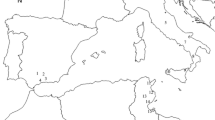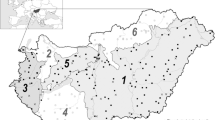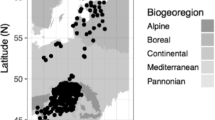Abstract
The aim of this study was to investigate the main climatic and biological trends related to olive flowering in central-southern Italy compared to those in Andalusia, Spain. Results since 1982 were compared for the two long-series monitoring areas of Cordoba and Perugia, and since 1992–1999 for the short-series areas. The relationship between climatic trends and the biological response of the olive, a widespread culture in the Mediterranean basin, were investigated. An aerobiological method involving capturing pollen released into the atmosphere was utilised as a bioindicator of flowering phenology. The study results confirm the strong relationship between flowering periods and spring temperature trends for the olive. Temperature during March, April and May was the parameter most related to flowering date in the study areas, particularly in Italy. In some cases we found a significant correlation between flowering and past autumn temperatures, probably due to their effect on floral bud dormancy induction, but this phenomenon appeared to be of minor importance in the studied areas. The phenological trend results show the continuous advance of flowering dates to the late 1990s, followed by a relatively stationary time series related to a short-term temperature fluctuation in the Mediterranean area. This latter period probably represents a mesoscale event forced by a macroscale event—the North Atlantic Oscillation. The results reveal that the trend towards increased temperatures, and the consequent flowering advance of some species, indicated some years ago is nowadays not as clear as was expected and should be confirmed over the next few years in the Mediterranean areas under investigation.






Similar content being viewed by others
References
Akin WE (1991) Global patterns: climate, vegetation and soils. University of Oklahoma Press, Norman, OK
Antognozzi E, Famiani F, Proietti P, Pannelli G, Alfei B (1993) Frost resistance of some olive cultivars during the winter. Acta Hortic 356:152–155
Antunes S, Pires O, Rochac A (2006) Detecting spatio-temporal precipitation variability in Portugal using multichannel singular spectral analysis. Int J Climatol 26:2199–2212
Arianoutsou FM, Diamantopoulos J (1985) Comparative phenology of 5 dominant plant species in maquis and phrygana ecosystems in Greece. Phyton 25(1):77–85
Avolio E, Pasqualoni L, Federico S, Fornaciari M, Bonofiglio T, Orlandi F, Bellecci C, Romano B (2008) Correlation between large scale atmospheric fields and olive pollen season in Central Italy. Int J Biometeorol 52(8):787–796
Barranco D, Fernández-Escobar R, Rallo L (1999) El cultivo del olivo. Coedición MundiPrensa y Consejería de Agricultura y Pesca de la Junta de Andalucía, Madrid
Béthoux JP, Gentili B, Tailliez D (1998) Warming and freshwater budget change in the Mediterranean since the 1940s, their possible relation to the greenhouse effect. Geophys Res Lett 25(7):1023–1026
Burn DH, Hag Elnur MA (2002) Detection of hydrologic trend and variability. J Hydrol 255:107–122
Chmielewski FM, Rotzer T (2001) Response of tree phenology to climate change across Europe. Agric Forest Meteorol 108:101–112
Chuine I, Cour P, Rousseau DD (1998) Fitting models predicting dates of flowering of temperate-zone trees using simulated annealing. Plant Cell Environ 21:455–466
Chuine I, Cour P, Rousseau DD (1999) Selecting models to predict the timing of flowering of temperate trees: implications for tree phenology modelling. Plant Cell Environ 22(1):1–13
Correia O, Martins AC, Catarino F (1992) Comparative phenology and seasonal foliar nitrogen variation in mediterranean species of Portugal. Ecol Mediterr 18:7–18
Fornaciari M, Galán C, Mediavilla A, Dominguez E, Romano B (2000a) Aeropalynological and phenological study in two olive mediterranean areas: Cordoba (Spagna) and Perugia (Italy). Plant Biosyst 134(2):199–204
Fornaciari M, Orlandi F, Romano B (2000b) Phenological and aeropalynological survey in an olive orchard in Umbria (Central Italy). Grana 39:246–251
Fornaciari M, Orlandi F, Romano B (2005) Yield forecasting for olive trees: a new approach in a historical series (Umbria, Central Italy). Agron J 97:1537–1542
Galán C, Cariñanos P, García-Mozo H, Alcázar P, Domínguez E (2001) Model for forecasting Olea europaea L. airborne pollen in South-West Andalusia, Spain. Int J Biometeorol 45(2):59–63
Galán C, Vázquez L, García-Mozo H, Domínguez E (2004) Forecasting olive (Olea europaea L.) crop yield based on pollen emission. Field Crop Res 86(1):43–51
Galán C, García-Mozo H, Vásquez L, Ruiz L, Guardia CD, Trigo MM (2005) Heat requirement for the onset of the Olea europeae L. pollen season in several sites in Andalusia and the effect of the expected future climate change. Int J Biometeorol 49:184–188
Galán C, Cariñanos P, García-Mozo H, Alcázar P, Domínguez E (2007) Management and Quality Manual. Spanish Aerobiology Network (REA). Servicio Publicaciones Universidad de Córdoba, Córdoba, Spain
García-Mozo H, Chuine I, Aira MJ, Belmonte J, Bermejo D, Díaz de la Guardia J, Elvira B, Gutiérrez M, Rodríguez-Rajo J, Ruiz L, Trigo MM, Tormo R, Valencia R, Galán C (2008a) Regional phenological models for forecasting the start and peak of the Quercus pollen season in Spain. Agric For Meteorol 148:372–380
Garcia Mozo H, Orlandi F, Galan C, Fornaciari M, Romano B, Ruiz L, Diaz de la Guardia C, Trigo MM, Chuine I (2008b) Olive flowering phenology variation between different cultivars in Spain and Italy: modelling analysis. Theor Appl Climatol 95:385–395
Geßler A, Keitel C, Kreuzwieser J, Matyssek R, Seiler W, Rennenberg H (2007) Potential risks for European beech (Fagus sylvatica L.) in a changing climate. Trees 21:1–11
Gilbert RO (1987) Statistical methods for environmental pollution monitoring. Van Nostrand Reinhold, New York
Hirst JM (1952) An automatic volumetric spore traps. Ann Appl Biol 39:257–265
Jacoboni N, Fontanazza G (1981) Le Cultivar di Olivo. Reda Ed, Rome, pp 9–52
Lavee S, Datt Z (1978) The necessity of cross-pollination for fruit set of Manzanillo olives. J Hortic Sci 53:261–266
López-Jurado JL, González-Pola C, Vélez-Belchí P (2005) Observation of an abrupt disruption of the long-term warming trend at the Balearic Sea, western Mediterranean Sea, in summer 2005. Geophys Res Lett 32:L24606
Mills TC (2004) Is the North Atlantic Oscillation a random walk? A comment with further results. Int J Climatol 24:377–383
Orlandi F, Garcia-Mozo H, Vazquez Ezquerra L, Romano B, Dominguez E, Galán C, Fornaciari M (2004) Phenological olive chilling requirements in Umbria (Italy) and Andalusia (Spain). Plant Biosyst 138(2):111–116
Orlandi F, Ruga L, Romano B, Fornaciari M (2005) An integrated use of aerobiological and phenological data to analyze flowering in olive groves. Grana 44:51–56
Osborne CP, Chuine I, Viner D, Woodward FI (2000) Olive phenology as a sensitive indicator of future climatic warming in the Mediterranean. Plant Cell Environ 23:701–710
Seager R et al (2002) Is the Gulf Stream responsible for Europe’s mild winters. Q J R Meteorol Soc 128(586):2563–2585
Sen P (1995) Robust and nonparametric methods in linear models with mixed-effects. Metrika 42(1):253–255
Sirois A (1998) A brief and biased overview of time series analysis or how to find that evasive trend. In WMO report No. 133: WMO/EMEP workshop on Advanced Statistical methods and their Application to Air Quality Data sets (Helsinki, 14–18 September 1998)
Wolfe DW, Schwartz MD, Lasko AN, Otsuki Y, Pool RM, Shaulis NJ (2005) Climate change and shifts in spring phenology of three horticultural woody perennials in northeastern USA. Int J Biometeorol 49:303–309
Author information
Authors and Affiliations
Corresponding author
Additional information
Carmen Galán and Marco Fornaciari contributed equally to this study.
Rights and permissions
About this article
Cite this article
Orlandi, F., Garcia-Mozo, H., Galán, C. et al. Olive flowering trends in a large Mediterranean area (Italy and Spain). Int J Biometeorol 54, 151–163 (2010). https://doi.org/10.1007/s00484-009-0264-x
Received:
Revised:
Accepted:
Published:
Issue Date:
DOI: https://doi.org/10.1007/s00484-009-0264-x




